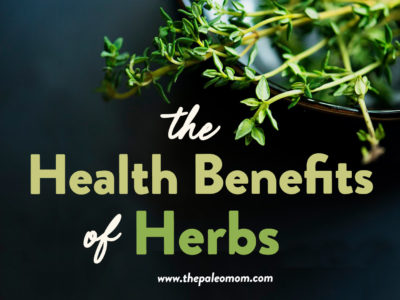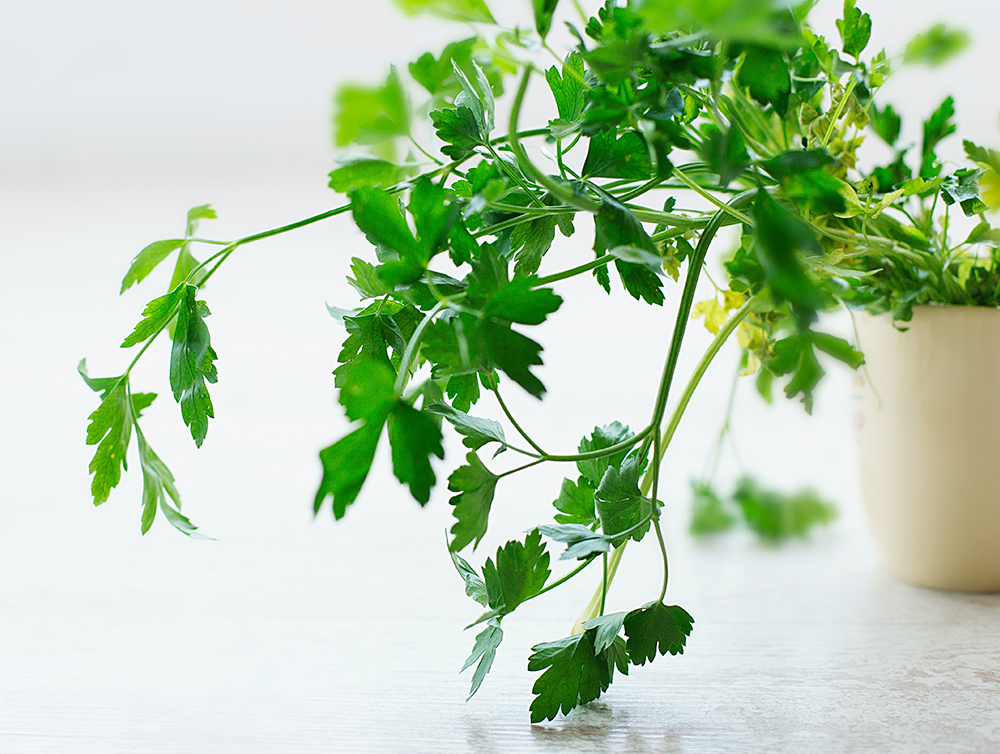 Herbs and spices are any savory, aromatic, edible plant used to flavor or garnish food (or in some cases, for their medicinal properties!). Although herbs and spices are often grouped together, and in some cases even come from the same plant (such as dill leaves and dill seeds), they have some key differences: spices are usually used when dried and are derived from seeds, barks, fruits, berries and roots, while herbs can be used fresh and are derived more often from the leaves, fronds, or flowering parts of a plant. We’ll save spices for a future article, so today, let’s dive into how herbs can add so much more than flavor to our lives!
Herbs and spices are any savory, aromatic, edible plant used to flavor or garnish food (or in some cases, for their medicinal properties!). Although herbs and spices are often grouped together, and in some cases even come from the same plant (such as dill leaves and dill seeds), they have some key differences: spices are usually used when dried and are derived from seeds, barks, fruits, berries and roots, while herbs can be used fresh and are derived more often from the leaves, fronds, or flowering parts of a plant. We’ll save spices for a future article, so today, let’s dive into how herbs can add so much more than flavor to our lives!
The list of culinary herbs is enormous, with many specific to certain cultures or regions, but some of the most widely used are:
- Basil (including sweet basil, holy basil, lemon basil, and Thai basil)
- Bay leaf
- Chamomile
- Chives
- Cilantro (did you know that somewhere between 3 and 21% of people experience cilantro as tasting soapy, due in part to variations in OR6A2—a gene that codes olfactory receptor proteins and enhances sensitivity to the aldehyde chemicals in this herb?)
- Dill leaves
- Fenugreek
- Jasmine
- Lavender
- Lemongrass
- Licorice
- Marjoram
- Mint (including peppermint and spearmint)
- Oregano
- Parsley
- Rosemary
- Sage
- Tarragon
- Thyme
…and that’s just a fraction!
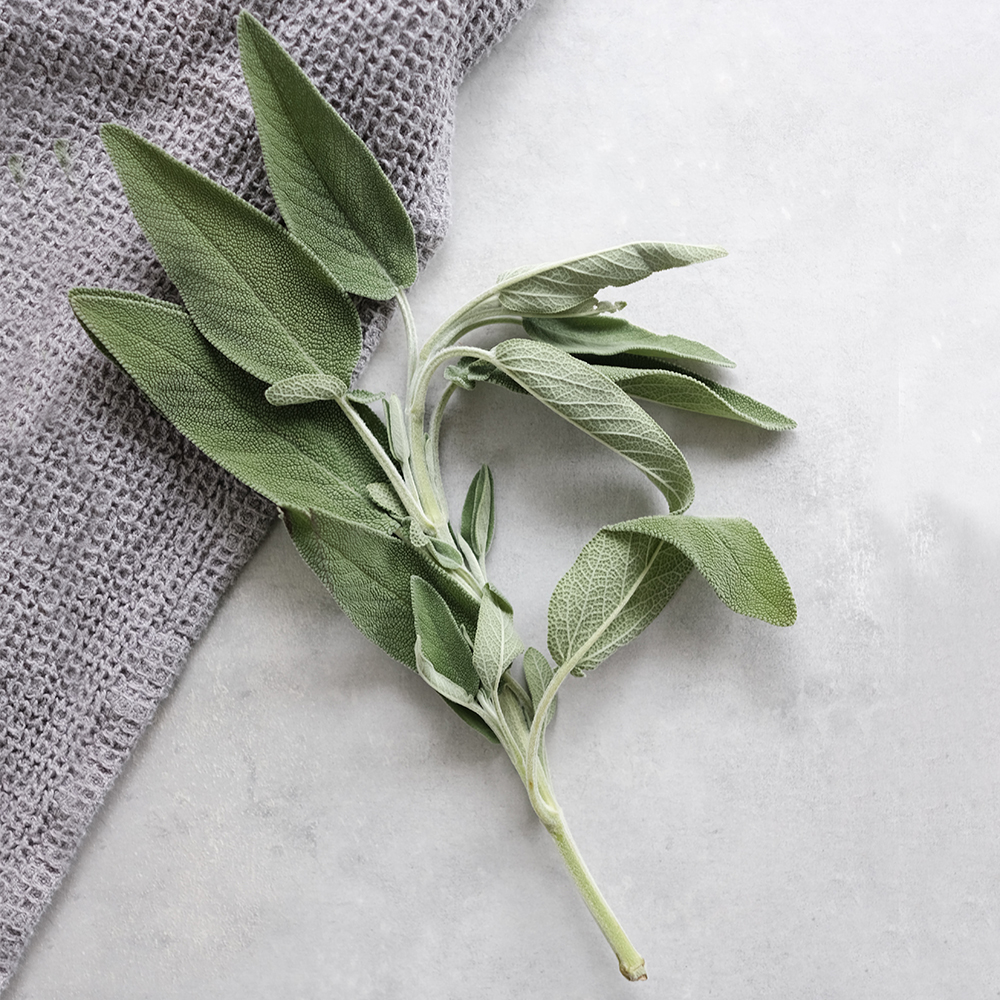 Herbs have been important to virtually every human culture scrolling back long before recorded history, and even show up on cave paintings in France dating as far back as 25,000 BCE. Ancient Egyptians began writing about herbs by the 28th century BCE, and by 700 BCE, Greek merchants were trading marjoram, sage, and thyme in markets in Athens (Hippocrates, the “father of medicine,” later catalogued 400 different herbs being used at the time!).
Herbs have been important to virtually every human culture scrolling back long before recorded history, and even show up on cave paintings in France dating as far back as 25,000 BCE. Ancient Egyptians began writing about herbs by the 28th century BCE, and by 700 BCE, Greek merchants were trading marjoram, sage, and thyme in markets in Athens (Hippocrates, the “father of medicine,” later catalogued 400 different herbs being used at the time!).
Basil, one of the most commonly used herbs globally, has played a role in cultures worldwide for over 4,000 years—including being used for embalming mummies in ancient Egypt, as a symbol of mourning in ancient Greece, as a spiritual protector in India, and an emblem to ward off evil in Crete! The word itself comes from the Greek basileus, meaning “kingly” or “royal plant.”
Likewise, sage was called “the holy herb” by the Romans (along with being incorporated into religious rituals, it was prescribed to help people digest meat and fatty foods!), was used by the Egyptians to promote fertility, and was used for tea by the French.
Thyme was placed under pillows during the Middle Ages to improve sleep and ward off nightmares, and during the bubonic plague, was one of the main ingredients in medical preparations, posies, and poultices for soothing plague-rashed skin (although the science wasn’t known at the time, we now know that thyme contains phytochemicals with antiseptic properties, particularly thymol!).
And while we might now think of herbs as helping flavor our dishes, in the days before refrigeration, it’s more likely they were used to disguise the taste of not-so-fresh foods (especially meat): strongly flavored herbs could mask the taste and smell of items that were going bad!
Nutrients in Fresh Herbs
Because they’re consumed in such small quantities, herbs don’t supply much in the way of calories, carbohydrates, fiber, fat, or protein; nor do they contain high levels of vitamins or minerals in the amounts we eat them. However, herbs are powerhouses of phytonutrients!
Depending on the herb, they contain phenolic acids, terpenes, flavonoids, sulfur-containing compounds, carotenoids, and more. For example, sage, oregano, rosemary, and thyme are rich in rosmarinic acid; peppermint, basil, thyme, oregano, lavender, and rosemary contain ursolic acid; dill, spearmint, rosemary, and basil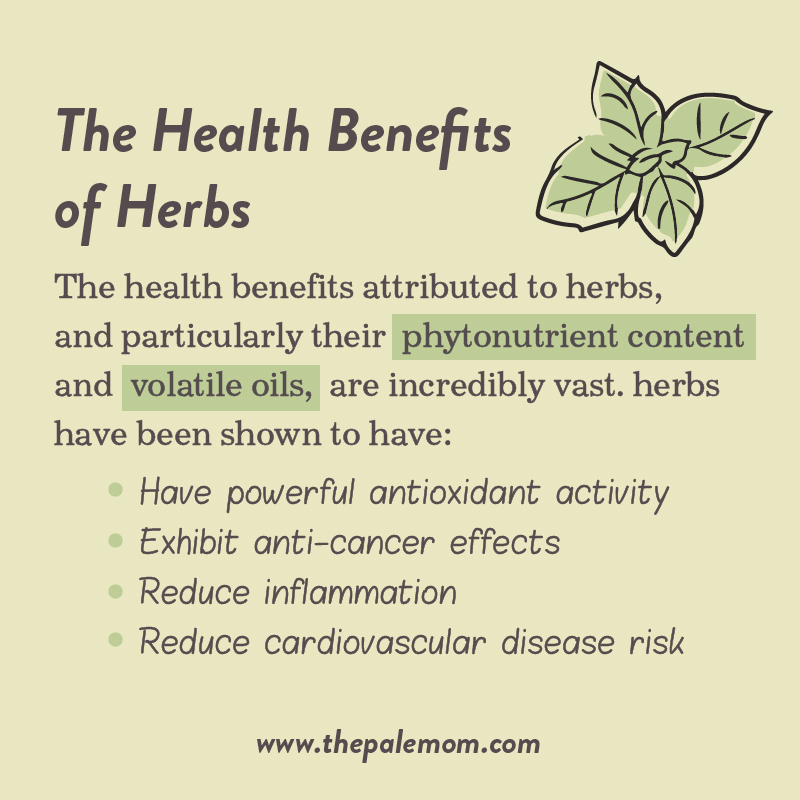 contain limonene; rosemary also contains rosmanol, naringin, cirsimaritin, and carnosic acid; cilantro contains lutein; chives contain kaempferol; parsley and celery leaf are rich in apiole; dill contains significant quercetin; and thymol and carvacrol are found in oregano. See also The Amazing World of Plant Phytochemicals and Polyphenols: Magic Bullet or Health Hype?.
contain limonene; rosemary also contains rosmanol, naringin, cirsimaritin, and carnosic acid; cilantro contains lutein; chives contain kaempferol; parsley and celery leaf are rich in apiole; dill contains significant quercetin; and thymol and carvacrol are found in oregano. See also The Amazing World of Plant Phytochemicals and Polyphenols: Magic Bullet or Health Hype?.
The Health Benefits of Herbs
The health benefits attributed to herbs, and particularly their phytonutrient content and volatile oils, are incredibly vast. In general, herbs have been shown to have powerful antioxidant activity, exhibit anti-cancer effects (especially due to polyphenols, terpenes, vanilloids, and organosulfur compounds), reduce inflammation (for example, basil, bay leaves, sage, thyme, licorice, and oregano have been shown to improve cytokine profiles), and reduce cardiovascular disease risk.
Nutrivore Weekly Serving Matrix
An easy-to-use and flexible weekly checklist
to help you maximize nutrient-density.
The Weekly Serving Matrix is very helpful! I’ve been eating along these lines but this really helps me know where to focus vs. which foods serve a more secondary role. It’s super helpful and has taken a lot of worry out of my meal planning. Thanks!
Jan
Individual herbs vary in their specific health effects, but they’re all awesome!
Health Benefits of Basil
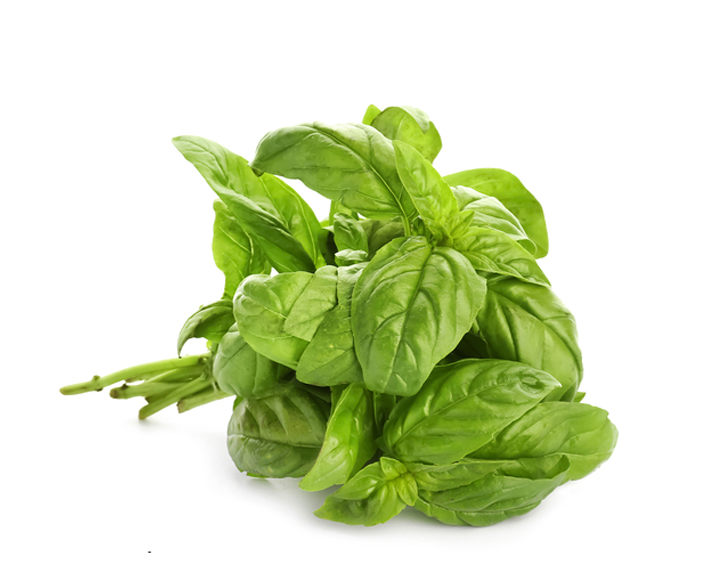
Sweet basil (in the form of extract) has been shown to reduce dental plaque, gingival bleeding, and cavity-causing bacteria in humans, suggesting a role for maintaining dental health. And rodent studies have shown that sweet basil has antidepressant-like effects, stroke-protective effects (reducing cerebral infarct size, short-term memory impairment, lipid peroxidation, and motor coordination impairment), anti-cancer effects (reducing the proliferation of cancer cells and stimulation apoptosis), and the ability to reduce platelet aggregation (suggesting a benefit for cardiovascular health).
A review of 24 clinical studies on holy basil (known as Tulsi in India and Nepal, where it’s been used in Ayurvedic medicine for over 3000 years) showed that this herb can significantly reduce blood sugar levels, reduce HbA1c (as well as enhance the HbA1c-lowering effects of antidiabetic drugs), improve blood pressure, reduce BMI among obese patients (for example, one randomized trial found a significant improvement in BMI, as well as blood lipids, following eight weeks of consuming 250 mg of holy basil extract twice daily), enhance immune response (including increased T-helper and natural killer cells), improve VO2 max, reduce asthma symptoms, improve cognitive function, and significantly improve stress and anxiety (particularly in studies lasting longer than a month). These diverse effects of holy basil are linked to its phytonutrients and bioactive secondary metabolites, including rosmarinic acid, ocimene, germacrene, and eugenol (which has been shown to reduce blood sugar levels by competitively preventing glucose from binding to serum albumin, as well as by preventing complex carbohydrates from getting converted into glucose).
Health Benefits of Mint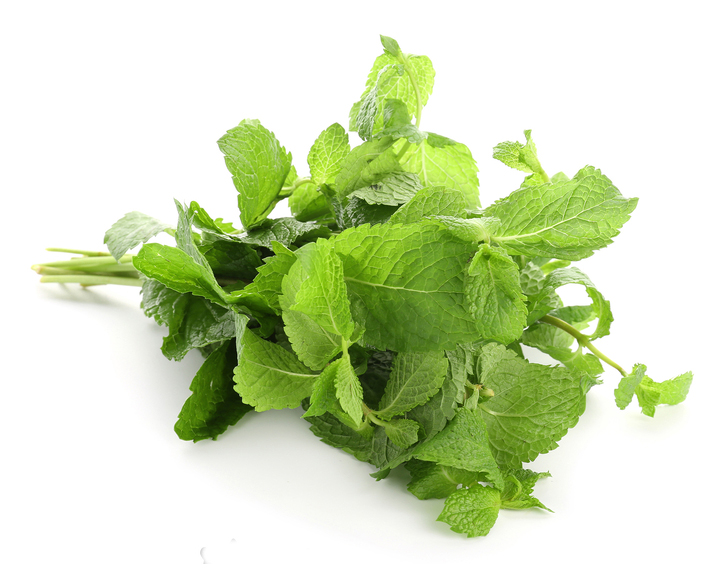
Mint, including peppermint and spearmint, has also demonstrated a number of health benefits—especially when it comes to gastrointestinal health! Numerous studies have shown that peppermint and peppermint oil can help relieve indigestion (including by decreasing the transit time of food out of the stomach), relieve IBS symptoms, and reduce nausea and abdominal pain. Mint contains some unique phytonutrients, such as the flavonones naringin, hesperidin, and eriocitrin, the phenolic acids caffeic acid, rosmarinic acid, lithospermic acid, and chlorogenic acid, the lignan medioresinol, and the monoterpenes menthol, limonene, and menthone—all of which contribute to its therapeutic effects.
Beyond boosting GI health, a recent review of peppermint research noted its radiation-protective properties (more specifically, it reduces radiation-induced chromosomal damage, intestinal barrier damage, and blood alterations, as well as dramatically increasing survival after radiation in mice!), a role for helping prevent and treat diabetes (including reducing blood glucose, C-peptide, insulin, urine urea, and uric acid levels in animal models of diabetes), protecting against liver damage (reducing serum alanine aminotransferase, asparate aminotransferase, alkaline phosphatase, lactate dehydrogenase, TBARS, and y-glutamyl transpeptidase, while increasing the growth and performance of liver function), and exhibiting antioxidant and anti-inflammatory activity.
Health Benefits of Rosemary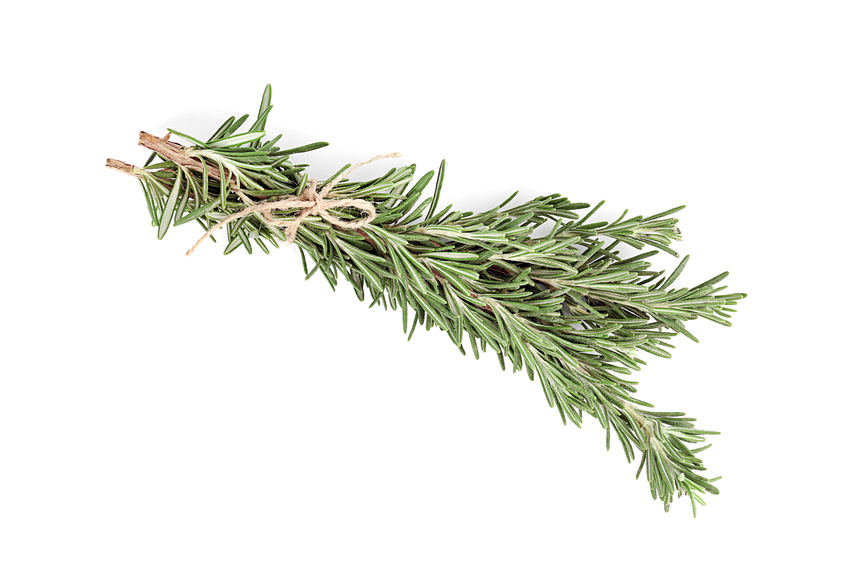
Rosemary has also emerged as a therapeutic agent when it comes to metabolic diseases and nervous system disorders! A variety of studies have shown that rosemary and its components (especially carnosic acid) have the ability to reduce blood sugar, normalize blood lipids, reduce inflammation, reduce blood pressure, protect against thrombosis, and protect against atherosclerosis, making it helpful for protecting against diabetes and heart disease.
A recent review of human and animal studies noted a therapeutic effect of rosemary on depression (likely due to its carnosol and ursolic acid content), memory and cognitive performance, Alzheimer’s disease, epilepsy, addiction (rosemary may help reduce symptoms of opioid withdrawal!), pain caused by nervous system diseases or disorders, stress and anxiety (rosemary has been shown to reduce serum corticosterone levels and increase dopamine in the brain), and Parkinson’s disease (the carnosic acid in rosemary protects against neurotoxicity in rodent models of Parkinson’s disease, likely due to its antioxidative and anti-apoptotic properties).
In addition, one review noted that rosemary’s phytonutrients are individually impressive: its caffeic acid has tumor-inhibiting effects, its carnosic acid can suppress lipogensis and reduce tumor growth, its chlorogenic acid has anti-colitis and kidney-protective properties, its rosmarinic acid can protect against nicotine-induced atherosclerosis, its ursolic acid can induce bone growth (by enhancing osteoblast activity and reducing osteoclast activity within the bone matrix), and its eucalyptol can reduce biofilm formation from pathogenic microbes.
Rosemary has also been shown to reduce asthma symptoms, help protect against peptic ulcers, reduce the development of cataracts, protect the liver from damage, serve as a muscle relaxant, and inhibit the proliferation of breast cancer, cervical cancer, colorectal cancer, esophageal cancer, lung cancer, and gastric cancer cells. Pretty great for one little herb!
Health Benefits of Oregano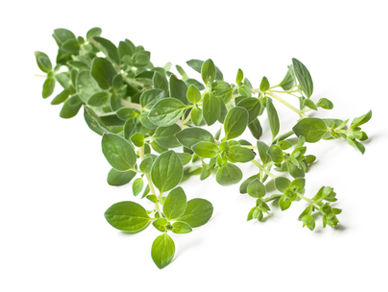
Oregano is also worth noting for its potential health benefits. Along with boasting significant antioxidant activity (due in large part to its flavonoid and phenolic acid content), oregano and oregano extracts have demonstrated antiproliferative and cytotoxic (cell-damaging or killing) activity against breast cancer cells, cervical cancer cells, lung cancer cells, colorectal cancer cells, and liver cancer cells.
Oregano may also support gastrointestinal health, with animal studies showing that oregano extract and oregano oil reduces inflammatory markers in the gut and protects against colon damage in a mouse model of colitis.
Health Benefits of Dill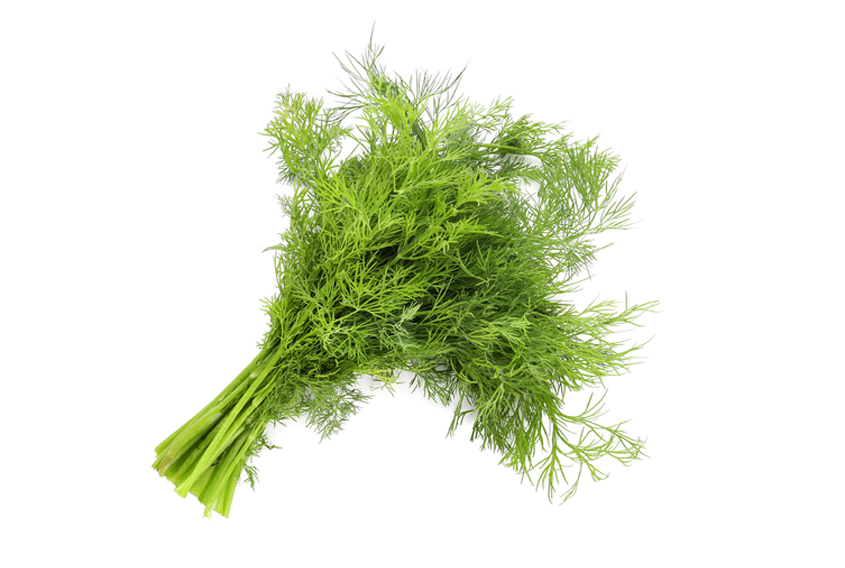
Dill, too, is as health-boosting as it is tasty! Across studies, dill and dill extract have demonstrated adaptogenic activity (reducing stress and boosting cognition), antidiabetic activity (significantly lowering blood sugar levels, triglycerides, and LDL cholesterol), anticancer activity against liver cancer and melanoma (through inducing the detoxifying enzyme glutathione S-transferase, with dill’s carvone content mostly responsible for triggering the enzyme activity), antispasmodic activity in the gut, and anti-inflammatory activity.
Health Benefits of Marjoram
Even marjoram has some exciting health properties. One review noted its antioxidant activity (mostly due to marjoram’s phenolic compounds of hydroxycinnamic acid, ursolic acid, carnosic acis, rosmarinic acid, caffeic acid, and carnosol), anti-inflammatory activity, anti-cancer effects against fibrosarcoma cells, liver cancer cells, and metastatic breast cancer cells, an ability to inhibit platelet aggregation, anti-ulcer effects, and even a role for helping regulate the menstrual cycle of women with polycystic ovarian syndrome (in one pilot study, marjoram tea significantly reduced dehydroepiandrosterone-S (DHEA-S) levels, helping normalize their hormonal profile).
Herbs Are Great for the Gut Microbiome
 The powerful phytochemicals in herbs also influence the gut microbiota. See also What Is the Gut Microbiome? And Why Should We Care About It?
The powerful phytochemicals in herbs also influence the gut microbiota. See also What Is the Gut Microbiome? And Why Should We Care About It?
When fed to rats, tannins (found in cloves, cumin, vanilla, cinnamon, tarragon, and thyme) have been shown to increase the Bacteroides group while significantly reducing the Clostridium leptum cluster. Rosemary extract has been shown to alleviate gut dysbiosis in chronic restraint stress mice, including restoring levels of Lactobacillus; other research has shown that rosemary extract fed to obese or lean mice increased levels of Blautia coccoides and Bacteroides/Prevotella, while also decreasing Clostridium leptum and increasing Bifidobacterium in the lean rats. Oregano oil may reduce serum endotoxin levels as well as E. coli, Proteus, Klebsiella, and Staphylococcus levels in the gut.
In fact, the antimicrobial effects of herbs and their constituents may help control the growth of potential pathogens.
The eugenol found in sage and basil can inhibit the growth of Shigella species, Salmonella enterica, and Listeria monocytogenes. Oregano (particularly its thymol and carbacrol content) likewise inhibits the growth of Aspergillus, Salmonella species, Shigella species, Salmonella enterica, Listeria monocytogenes, E. coli, and Vibrio parahaemolyticus. Dill has demonstrated antimicrobial activity against E. coli and Yersinia enterococolitica, while marjoram can inhibit the growth of Staphylococcus aureus, Bacillus cereus, Bacillus subtilis, and E. coli. Thyme, rich in thymol, caffeic acid, and carvacrol, has demonstrated antimicrobial activity against Bacillus subtilis, E. coli, Salmonella enterica, Listeria monocytogenes, Staphylococcus aureus, and Vibrio parahaemolyticus. Likewise, rosemary extract can reduce biofilms produced by Candida albicans, Staphylococcus aureus, and Eubacterium faecalis.
Fascinatingly, some research has shown that the anti-depressive effects of rosemary may be mediated (at least in part) by shifts in the gut microbiota—in particular, enhancing Lactobacillus and Firmicutes and reducing Bacteroidetes and Proteobacteria.
Peppermint essential oil has been shown to have antimicrobial activity against a number of potential pathogens, including Klebsiella species, Staphylococcus aureus, Mirococcus flavus, Salmonella enteritides, Escherichia coli, Bacillus subtilis, Bacillus cereus, and Pseudomonas fluorescence. In vitro, peppermint oil and leaves can also inhibit the growth of the fungi Candida albicans, Rhizopus nigricans, and some Fusarium species, as well as the herpes simplex virus (HSV-1 and HSV-2), influenza A, newcastle disease virus, and H1N1 (although we don’t have sufficient research to see how it bares out in human bodies!).
 Herbs for the Win!
Herbs for the Win!
Given that different herbs bring such diverse benefits for our health, we should strive for variety here! Luckily, there’s no shortage of delicious recipes that incorporate these awesome, phytonutrient-rich plant foods. For example, check out this Truffle Salt and Thyme Broiled Salmon with Dill Caper Sauce (you’ll get an herb and spice three-for-one with thyme, dill, and capers!), Pan-Seared Tarragon Whitefish Fillet, Minted Zucchini, Thai Green Curry made with lemongrass and cilantro and basil, or Spaghetti Squash with Sage and Brown Butter. No matter what way you slice (or chop!) them, herbs deliver a health-promoting boost of flavor and beneficial phytonutrients!
Citations
Ali SS, et al. “The antidepressant-like effect of Ocimum basilicum in an animal model of depression.” Biotech Histochem. 2017;92(6):390-401. doi: 10.1080/10520295.2017.1323276. Epub 2017 Aug 11.
Amrani S, et al. “Vasorelaxant and anti-platelet aggregation effects of aqueous Ocimum basilicum extract.” J Ethnopharmacol. 2009 Aug 17;125(1):157-62. doi: 10.1016/j.jep.2009.05.043. Epub 2009 Jun 6.
Bina F & Rahimi R. “Sweet Marjoram: A Review of Ethnopharmacology, Phytochemistry, and Biological Activities.” J Evid Based Complementary Altern Med. 2017 Jan;22(1):175-185. doi: 10.1177/2156587216650793. Epub 2016 May 26.
Bora KS, et al. “Role of Ocimum basilicum L. in prevention of ischemia and reperfusion-induced cerebral damage, and motor dysfunctions in mice brain.” J Ethnopharmacol. 2011 Oct 11;137(3):1360-5. doi: 10.1016/j.jep.2011.07.066. Epub 2011 Aug 5.
Delaquis PJ, et al. “Antimicrobial activity of individual and mixed fractions of dill, cilantro, coriander and eucalyptus essential oils.” Int J Food Microbiol. 2002 Mar 25;74(1-2):101-9. doi: 10.1016/s0168-1605(01)00734-6.
Elansary HO & Mahmoud EA. “In vitro antioxidant and antiproliferative activities of six international basil cultivars.” Nat Prod Res. 2015;29(22):2149-54. doi: 10.1080/14786419.2014.995653. Epub 2015 Jan 2.
Guldiken B, et al. “Phytochemicals of herbs and spices: Health versus toxicological effects.” Food Chem Toxicol. 2018 Sep;119:37-49. doi: 10.1016/j.fct.2018.05.050. Epub 2018 May 23.
Guo Y, et al. “Antidepressant Effects of Rosemary Extracts Associate With Anti-inflammatory Effect and Rebalance of Gut Microbiota.” Front Pharmacol. 2018 Oct 2;9:1126. doi: 10.3389/fphar.2018.01126. eCollection 2018.
Gutiérrez-Grijalva EP, et al. “Flavonoids and Phenolic Acids from Oregano: Occurrence, Biological Activity and Health Benefits.” Plants (Basel). 2017 Dec 26;7(1):2. doi: 10.3390/plants7010002.
Hassani FV, et al. “Rosemary (Rosmarinus officinalis) as a potential therapeutic plant in metabolic syndrome: a review.” Naunyn Schmiedebergs Arch Pharmacol. 2016 Sep;389(9):931-49. doi: 10.1007/s00210-016-1256-0. Epub 2016 May 13.
Husein IH, et al. “The effect of marjoram (Origanum majorana) tea on the hormonal profile of women with polycystic ovary syndrome: a randomised controlled pilot study.” J Hum Nutr Diet. 2016 Feb;29(1):105-11. doi: 10.1111/jhn.12290. Epub 2015 Feb 9.
Jamshidi N & Cohen MM. “The Clinical Efficacy and Safety of Tulsi in Humans: A Systematic Review of the Literature.” Evid Based Complement Alternat Med. 2017;2017:9217567. doi: 10.1155/2017/9217567. Epub 2017 Mar 16.
Khanna R, et al. “Peppermint oil for the treatment of irritable bowel syndrome: a systematic review and meta-analysis.” J Clin Gastroenterol. 2014 Jul;48(6):505-12. doi: 10.1097/MCG.0b013e3182a88357.
Lai PK & Roy J. “Antimicrobial and chemopreventive properties of herbs and spices.” Curr Med Chem. 2004 Jun;11(11):1451-60. doi: 10.2174/0929867043365107.
Mahendran G & Rahman LU. “Ethnomedicinal, phytochemical and pharmacological updates on Peppermint (Mentha × piperita L.)-A review.” Phytother Res. 2020 Sep;34(9):2088-2139. doi: 10.1002/ptr.6664. Epub 2020 Mar 16.
Oliveira JR, et al. “Rosmarinus officinalis L. (rosemary) as therapeutic and prophylactic agent.” J Biomed Sci. 2019 Jan 9;26(1):5. doi: 10.1186/s12929-019-0499-8.
Rahbardar MG, et al. “Therapeutic effects of rosemary ( Rosmarinus officinalis L.) and its active constituents on nervous system disorders.” Iran J Basic Med Sci. 2020 Sep;23(9):1100-1112. doi: 10.22038/ijbms.2020.45269.10541.
Romo-Vaquero M, et al. “A rosemary extract rich in carnosic acid selectively modulates caecum microbiota and inhibits β-glucosidase activity, altering fiber and short chain fatty acids fecal excretion in lean and obese female rats.” PLoS One. 2014 Apr 14;9(4):e94687. doi: 10.1371/journal.pone.0094687. eCollection 2014.
Sataphathy S, et al. “Effect of Tulsi ( Ocimum sanctum Linn.) Supplementation on Metabolic Parameters and Liver Enzymes in Young Overweight and Obese Subjects.” Indian J Clin Biochem. 2017 Jul;32(3):357-363. doi: 10.1007/s12291-016-0615-4. Epub 2016 Sep 16.
Singletary, Keith W. “Basil: A Brief Summary of Potential Health Benefits.” Nutrition Today 2018;53(2):92-97.
Smith A & Mackie RI. “Effect of condensed tannins on bacterial diversity and metabolic activity in the rat gastrointestinal tract.” Appl Environ Microbiol. 2004 Feb;70(2):1104-15. doi: 10.1128/aem.70.2.1104-1115.2004.
Veenstra JP & Johnson JJ. “Oregano (Origanum vulgare) extract for food preservation and improvement in gastrointestinal health.” Int J Nutr. 2019;3(4):43-52. doi: 10.14302/issn.2379-7835.ijn-19-2703. Epub 2019 Apr 9.
Zou Yi, et al. “Oregano Essential Oil Improves Intestinal Morphology and Expression of Tight Junction Proteins Associated with Modulation of Selected Intestinal Bacteria and Immune Status in a Pig Model.” Biomed Res Int. 2016;2016:5436738. doi: 10.1155/2016/5436738. Epub 2016 May 29.

